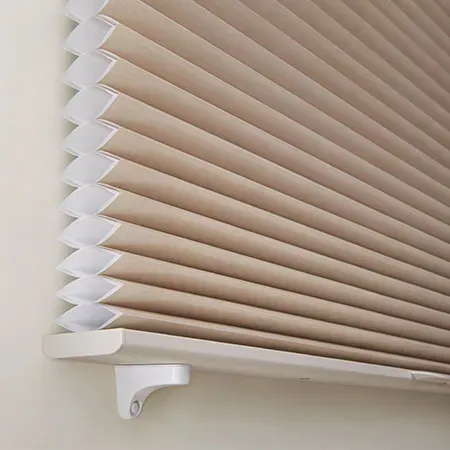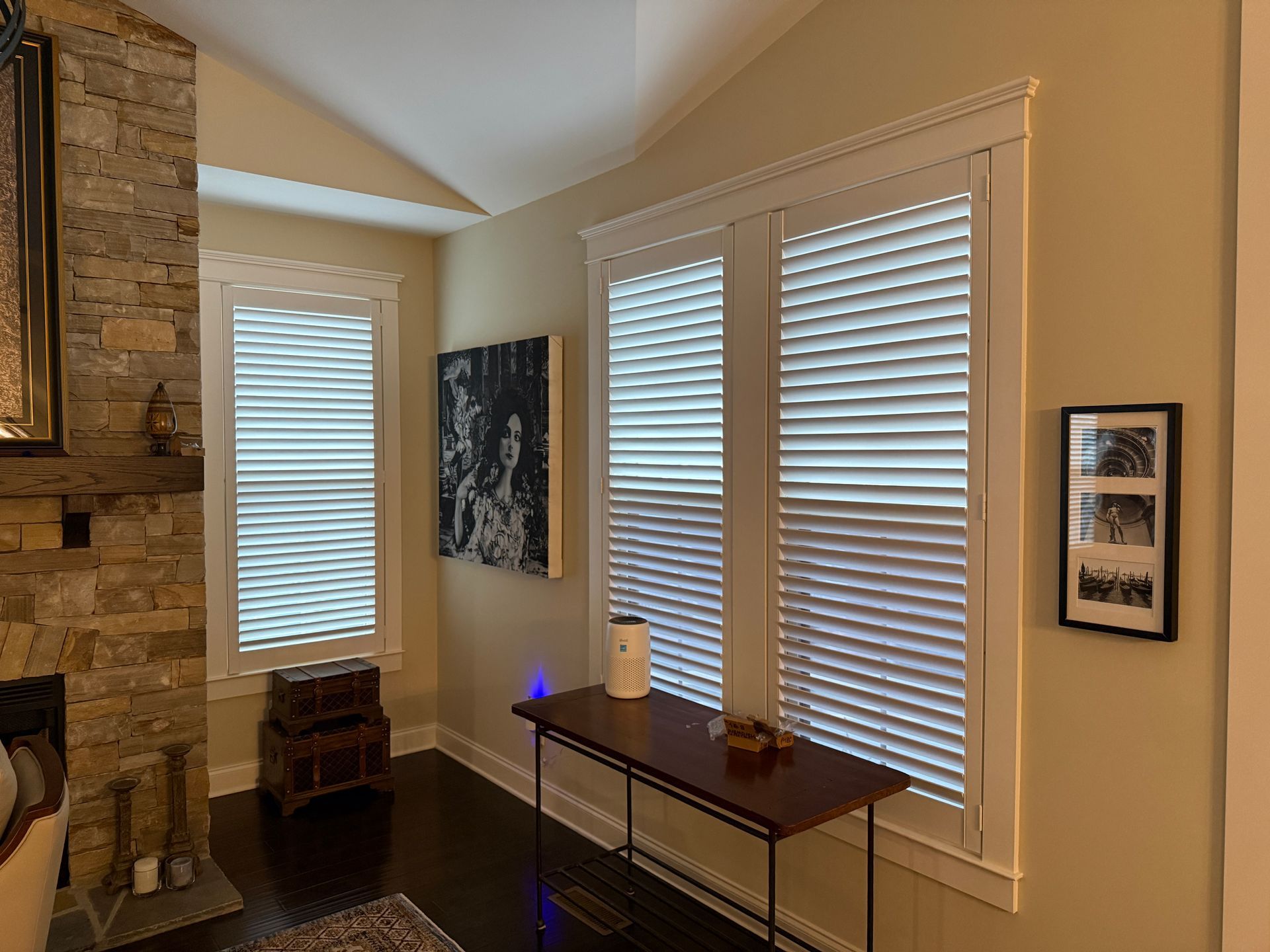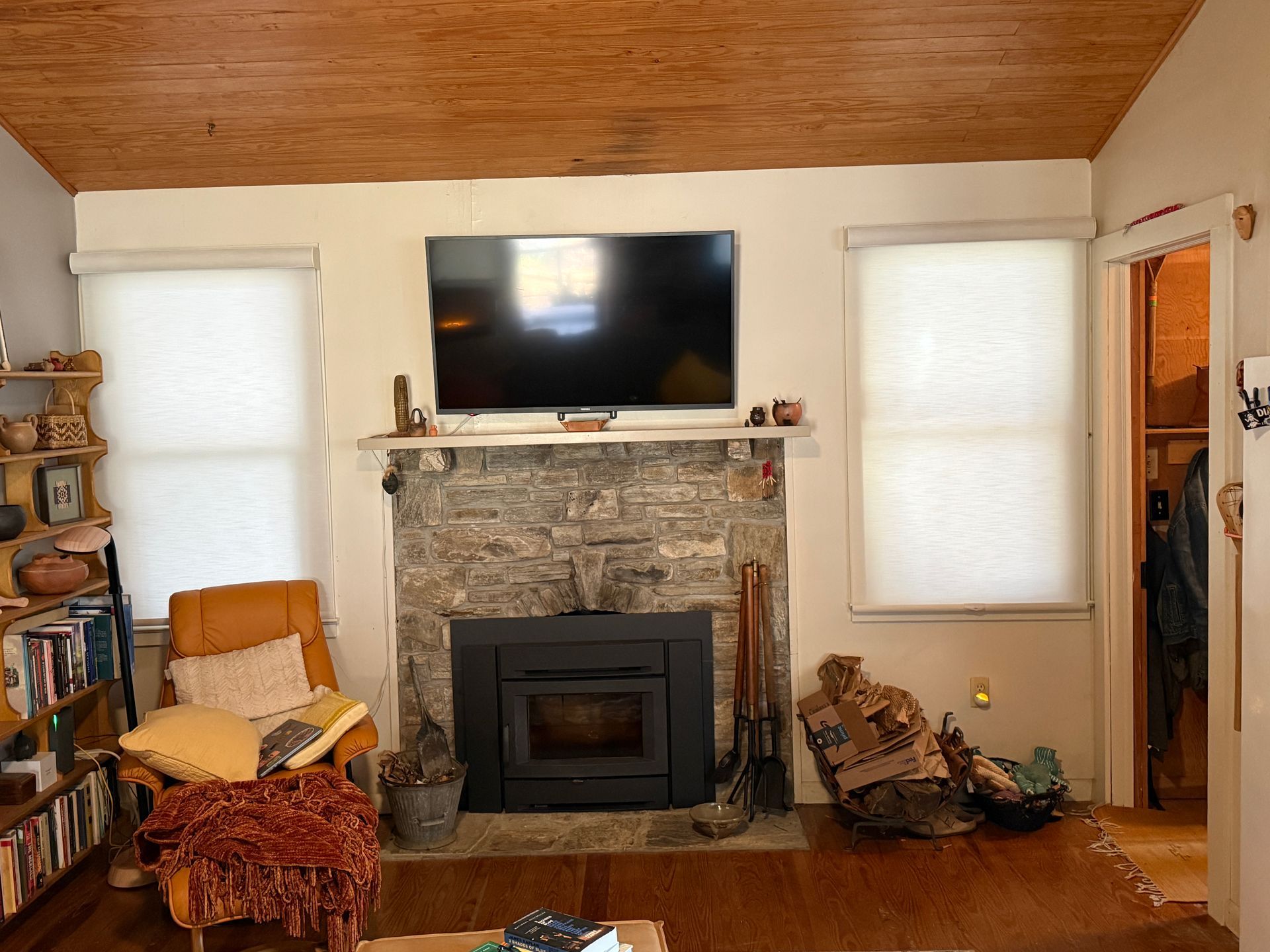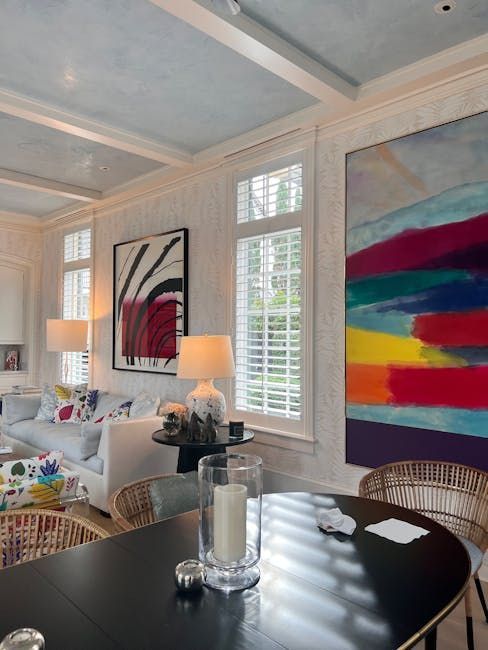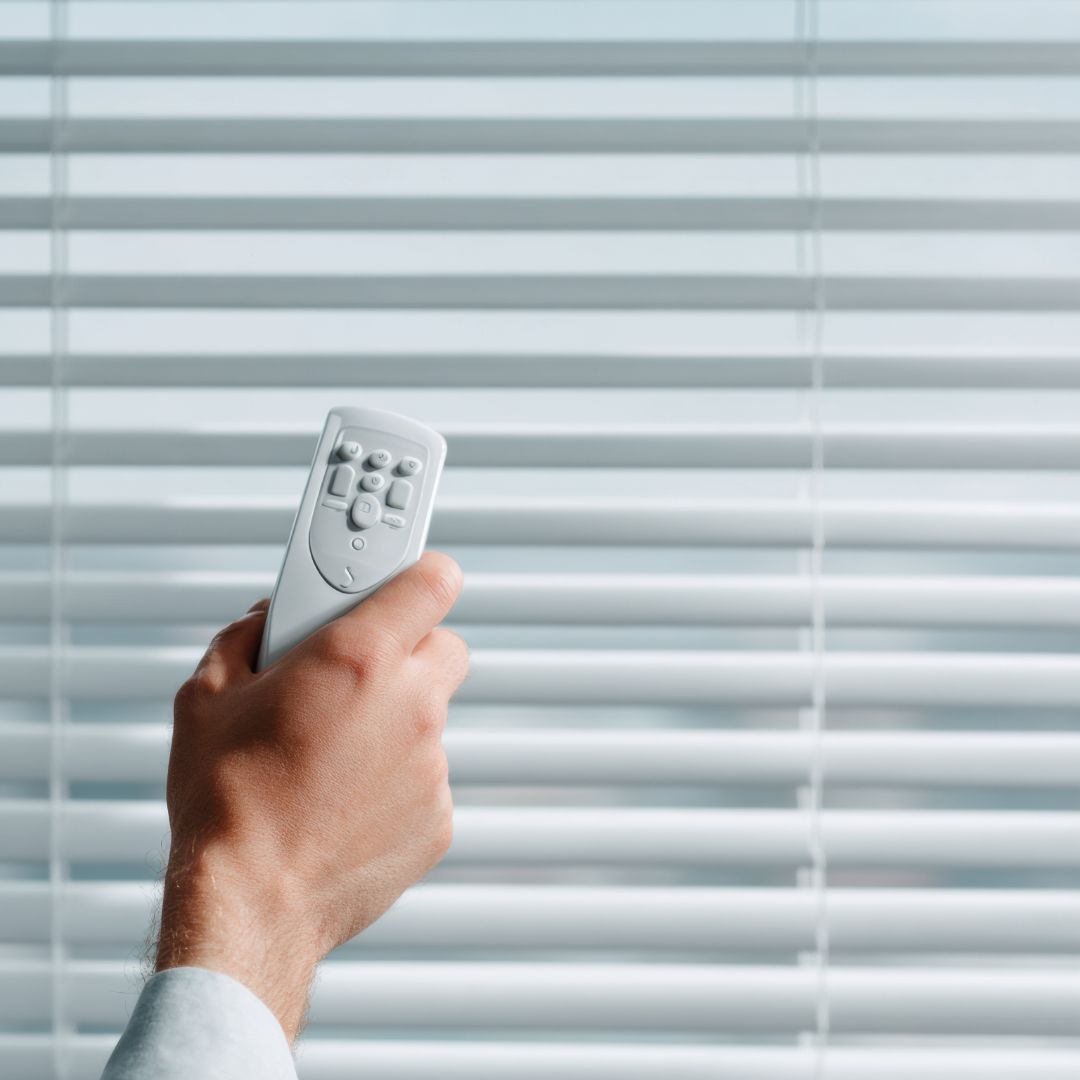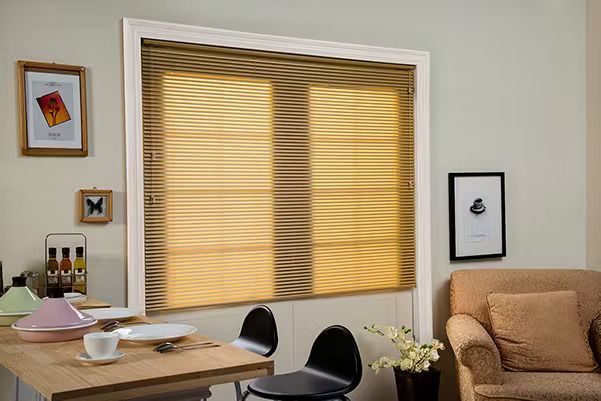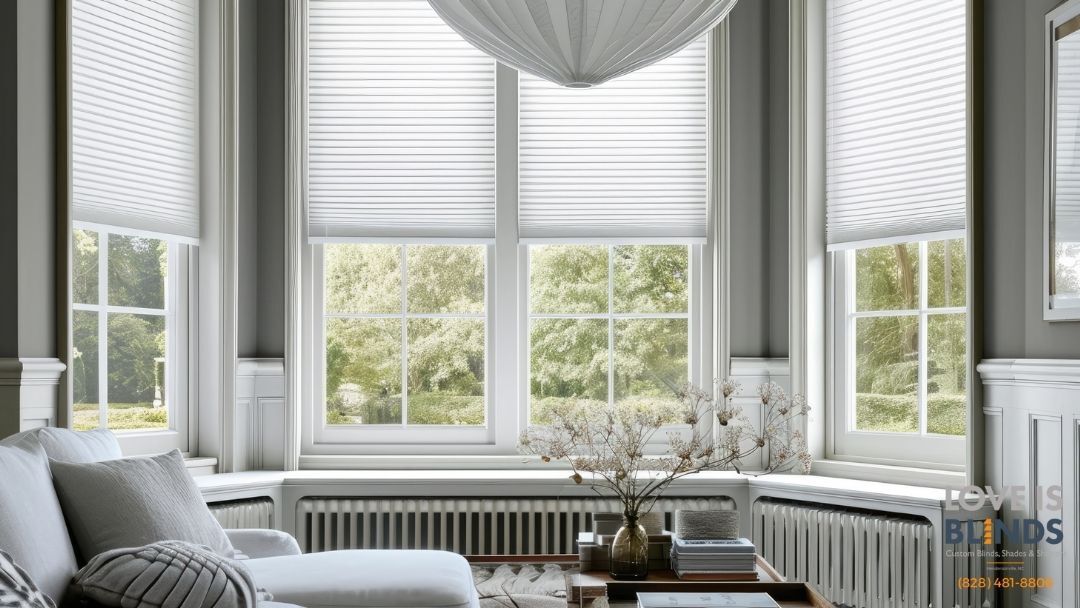Energy Efficient Window Treatments Asheville NC: Save Money & Improve Comfort Year-Round
Energy Efficient Window Treatments Asheville NC
When those Asheville winter winds start howling down from the Blue Ridge Mountains, or when summer's intense mountain sun beats through your windows, you might notice something alarming happening to your energy bills. They're climbing faster than hikers on the Appalachian Trail. If you've been wondering why your HVAC system seems to run constantly despite having a well-insulated home, the answer might be staring you right in the face – or rather, letting all that expensive heated and cooled air escape right through your windows.
Energy efficient window treatments in Asheville NC aren't just about keeping your home comfortable; they're about putting real money back in your pocket month after month. With our unique mountain climate that can swing from freezing mornings to warm afternoons, sometimes in the same day, having the right window coverings isn't a luxury – it's a necessity. The Department of Energy reports that windows account for 25-30% of residential heating and cooling energy use, but here in Western North Carolina's variable climate, that percentage can be even higher.
At Love Is Blinds NC, we've spent over a decade helping Asheville homeowners transform their windows from energy drains into efficiency powerhouses. We've seen firsthand how the right window treatments can reduce utility bills by up to 30% while making homes noticeably more comfortable year-round. This comprehensive guide will walk you through everything you need to know about choosing, installing, and maximizing energy efficient window treatments for your mountain home.
1. Understanding Energy Loss Through Windows in Asheville Homes
Before diving into solutions, it's crucial to understand why windows are such significant energy culprits in our mountain homes. Windows are essentially holes in your home's insulation envelope, and even the best double-pane windows have an R-value (insulation rating) of only about 3-4, compared to an insulated wall's R-value of 13-20. This disparity becomes even more pronounced in Asheville's climate, where we experience both heating and cooling extremes throughout the year.
The physics of energy loss through windows involves three main mechanisms: conduction, convection, and radiation. Conduction occurs when heat transfers directly through the window materials – glass, frame, and spacers. On those crisp Asheville mornings when frost covers the valley, you can actually feel this process by touching a cold window pane. Convection happens when air currents carry heat away from or toward the window surface, creating those uncomfortable drafts many homeowners experience. Radiation, particularly solar radiation, is when the sun's energy passes through the glass, heating up your interior spaces – wonderful in winter, but problematic during our increasingly warm summers.
Our elevation here in Western North Carolina adds another layer of complexity to window energy efficiency. At around 2,134 feet above sea level, Asheville receives more intense UV radiation than lower elevations, meaning solar heat gain through windows is amplified. Additionally, our mountain location creates unique weather patterns with dramatic temperature swings. It's not uncommon to need heating in the morning and cooling by afternoon, especially during shoulder seasons. This constant HVAC cycling can drive energy costs through the roof if your windows aren't properly dressed.
Historic homes, which make up a significant portion of Asheville's housing stock, face particular challenges. Many beautiful homes in neighborhoods like Montford or Biltmore Forest feature original single-pane windows that, while architecturally stunning, offer virtually no insulation value. These windows can lose up to ten times more energy than modern energy-efficient windows. However, replacing historic windows isn't always feasible or desirable, making energy efficient window treatments an essential retrofit solution.
The financial impact of window energy loss in Asheville can be staggering. Based on local utility rates from Duke Energy, the average 2,000 square foot home with inefficient windows can waste $400-600 annually on heating and cooling. Over a decade, that's $4,000-6,000 literally going out the window. When you consider that quality energy efficient window treatments typically cost a fraction of window replacement and can reduce these losses by 25-40%, the return on investment becomes crystal clear.
2. The Science Behind Energy Efficient Window Treatments
Energy efficient window treatments work by creating barriers that interrupt the three methods of heat transfer we discussed earlier. The most effective treatments create multiple layers of protection, each addressing different aspects of energy loss. Think of it like dressing for an Asheville winter hike – layers are key to maintaining comfortable temperatures as conditions change.
The concept of dead air space is fundamental to understanding how window treatments save energy. Still air is an excellent insulator, which is why double-pane windows work better than single-pane. Energy efficient window treatments expand on this principle by creating additional pockets of trapped air between your room and the window. Cellular shades, for instance, feature honeycomb-shaped cells that trap air, creating an insulating barrier. The more cells (double or triple cell designs), the better the insulation value.
Reflectivity plays a crucial role in managing solar heat gain, particularly important given Asheville's intense mountain sun exposure. Window treatments with reflective backings can bounce solar radiation back outside before it enters your home. This is especially valuable for west-facing windows that bear the brunt of afternoon sun. Some modern treatments feature metalized coatings that can reflect up to 80% of solar heat while still allowing natural light to filter through.
The seal between the window treatment and the window frame dramatically impacts efficiency. Even the most insulating shade loses effectiveness if air can flow around its edges. This is why proper installation is crucial – a gap of just 1/8 inch around a window treatment can reduce its insulating value by up to 50%. Professional installation ensures treatments fit snugly, with side tracks or magnetic seals that eliminate gaps where energy can escape.
Modern energy efficient treatments also incorporate phase-change materials and advanced fabrics that actively manage temperature. These materials absorb excess heat during the day and release it at night, helping to moderate temperature swings – perfect for Asheville's variable climate. Some treatments even feature different properties on each side, with a heat-absorbing dark side for winter and a reflective light side for summer, allowing homeowners to reverse them seasonally.
3. Top Energy Efficient Window Treatment Options for WNC Homes
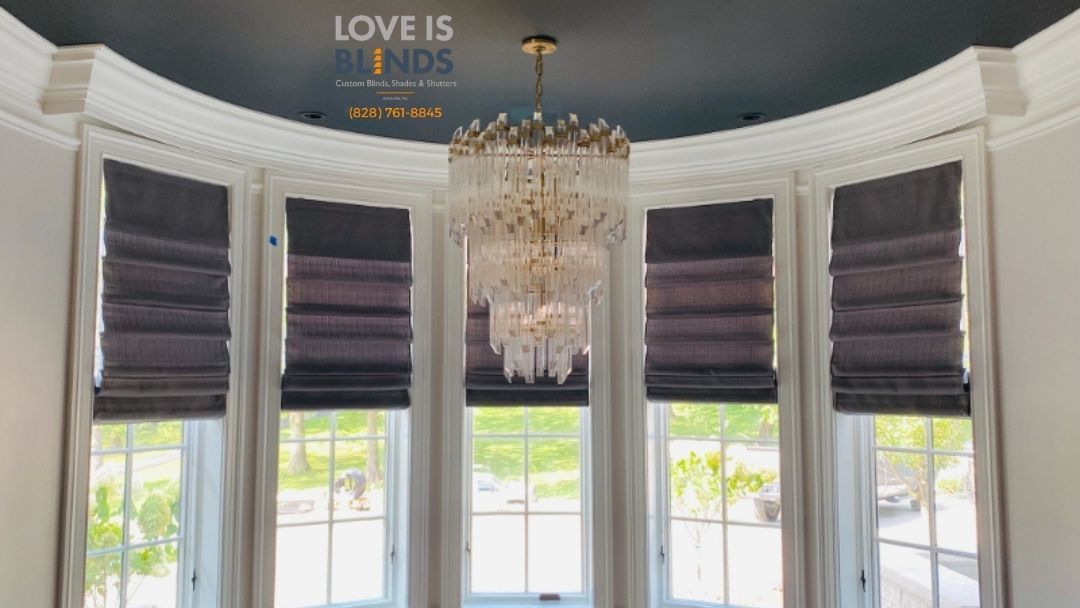
When it comes to selecting energy efficient window treatments for your Asheville home, you have more options than ever before. Each type offers different benefits, aesthetics, and efficiency levels. Let's explore the top performers that work exceptionally well in our mountain climate.
Cellular (Honeycomb) Shades are the gold standard for energy efficiency. These innovative shades feature a unique honeycomb design that creates air pockets, providing superior insulation. In Asheville homes, we typically recommend double-cell shades for maximum efficiency. They can reduce heat loss through windows by up to 40% in winter and cut unwanted solar heat gain by up to 80% in summer. The best models feature an R-value of 5 or higher – more than doubling the insulation value of a standard double-pane window. For homes near the Blue Ridge Parkway or in higher elevations where temperature extremes are more pronounced, triple-cell options provide even better protection.
Insulated Roman Shades combine classic elegance with modern efficiency. Unlike standard Roman shades, insulated versions feature multiple layers including a vapor barrier, insulating material, and decorative fabric. They're particularly popular in Asheville's historic districts where homeowners want to maintain period-appropriate aesthetics while improving efficiency. When properly fitted with side seals, insulated Roman shades can reduce heat loss by 25-35%. They're especially effective in bedrooms where the added benefit of room darkening helps with sleep quality – important for those living near busy areas like downtown or Tunnel Road.
Plantation Shutters offer durability and excellent light control along with solid energy efficiency. Quality shutters create an effective barrier against heat transfer, particularly when closed tightly. In Asheville's variable climate, the adjustable louvers allow precise control over solar heat gain – you can angle them to block direct sun while maintaining views of our beautiful mountains. Composite or vinyl shutters provide better insulation than wood, with some models achieving R-values of 3-4. They're virtually maintenance-free, which is valuable given our humid summers and occasional severe weather.
Thermal Drapes and Curtains might seem old-fashioned, but modern versions incorporate high-tech materials that dramatically improve window efficiency. Quality thermal drapes feature multiple layers including a vapor barrier, thick insulating material, and reflective backing. When installed properly with sealed edges and adequate overlap, they can reduce heat loss by up to 25%. They work particularly well in combination with other treatments – many Asheville homeowners pair them with roller shades or custom blinds for maximum flexibility and efficiency.
Automated and Motorized Treatments represent the cutting edge of energy efficiency. By programming treatments to respond to temperature, sunlight, or time of day, you can optimize energy savings without lifting a finger. Motorized systems are particularly valuable for hard-to-reach windows or for managing multiple windows simultaneously. During summer, they can automatically close during peak sun hours, reducing cooling loads by up to 30%. In winter, they can open to capture free solar heat during the day and close at dusk to retain warmth. Integration with smart home systems allows for sophisticated scheduling that adapts to Asheville's changing seasons.
4. Room-by-Room Energy Efficiency Strategies

Different rooms in your Asheville home have unique energy efficiency needs based on their use, orientation, and exposure. Understanding these differences helps you choose the most effective window treatments for each space, maximizing both comfort and energy savings throughout your home.
Living Rooms and Great Rooms often feature large windows or sliding glass doors that showcase mountain views but can be major sources of energy loss. These spaces typically require a balance between maintaining views, controlling glare, and managing temperature. For south-facing living rooms that receive intense midday sun, we recommend dual shades – a light-filtering shade for daytime use paired with an insulating cellular shade for evening and extreme weather. Many homes in areas like Biltmore Forest or Town Mountain use top-down/bottom-up cellular shades that allow privacy at street level while maintaining mountain views above. The ability to adjust coverage throughout the day can reduce HVAC runtime by 2-3 hours daily during peak seasons.
Bedrooms require special consideration for both energy efficiency and sleep quality. The ideal bedroom window treatment blocks light completely while providing superior insulation for comfortable sleeping temperatures. Double-cell blackout cellular shades are incredibly popular in Asheville bedrooms, especially for shift workers at Mission Hospital or those sensitive to early morning light. These shades can maintain bedroom temperatures 3-5 degrees cooler in summer and warmer in winter compared to standard blinds. For children's rooms, cordless options provide safety while maintaining efficiency. Consider adding insulated curtains over cellular shades for maximum insulation – this combination can achieve R-values approaching 7, nearly matching wall insulation levels.
Kitchen and Dining Areas present unique challenges with moisture, cooking heat, and the need for natural light during meal preparation. Faux wood blinds or moisture-resistant cellular shades work well in these spaces, resisting humidity while providing adjustable light control. For breakfast nooks with eastern exposure – common in neighborhoods like Kenilworth or Five Points – consider solar shades that reduce glare and heat while preserving the cheerful morning light that makes these spaces special. Many Asheville homeowners appreciate automated shades in dining rooms that can be programmed to adjust for dinner parties or to protect furniture and artwork from UV damage.
Home Offices have become increasingly important, especially with more Asheville residents working remotely. These spaces need treatments that reduce glare on computer screens while maintaining adequate natural light to reduce eye strain. Dual roller shades – one solar screen for glare control and one blackout for video calls – provide maximum flexibility. Position desks perpendicular to windows when possible, and use adjustable treatments to manage changing light throughout the day. Studies show proper light management in home offices can improve productivity by 15% while reducing the need for artificial lighting by up to 40%.
Bathrooms require moisture-resistant treatments that provide privacy while allowing ventilation. Vinyl or composite shutters excel in bathroom environments, resisting warping and mildew that can affect wood products in our humid climate. Top-down cellular shades allow privacy while maintaining natural light and ventilation at the top of the window. For bathroom windows facing neighbors – common in dense neighborhoods like West Asheville or Montford – consider frosted window film combined with a moisture-resistant shade for the perfect balance of privacy and efficiency.
5. Seasonal Strategies for Maximum Energy Savings
Asheville's four distinct seasons each bring unique energy challenges. Understanding how to adjust your window treatment strategy seasonally can dramatically improve both comfort and efficiency. The key is working with our climate rather than against it, using window treatments to capture free solar heat in winter and block unwanted heat in summer.
Winter Optimization (December-February) in Asheville requires a delicate balance. While our winters are milder than many mountain regions, we still experience freezing temperatures and occasional snow. During sunny winter days, open south-facing window treatments to capture free solar heat – the low winter sun angle means maximum heat gain without summer's overwhelming intensity. Studies show this passive solar heating can reduce heating costs by 10-15%. Close all treatments at dusk to create an insulating barrier against cold nights. For optimal efficiency, ensure treatments seal tightly against frames to prevent cold drafts. North-facing windows should generally remain covered during winter months as they provide no solar gain but significant heat loss.
Spring Adaptation (March-May) brings Asheville's famous wildflowers and widely variable temperatures. This is when programmable or smart motorized treatments really shine, automatically adjusting to changing conditions. Morning temperatures might require closed treatments for warmth, while afternoons need solar protection. Pollen season – particularly intense in our mountain environment – makes this a great time to keep windows closed and rely on treatments for temperature control rather than ventilation. Consider installing new treatments during spring when you can properly assess both heating and cooling needs.
Summer Protection (June-August) focuses on blocking solar heat gain while maintaining natural light. Our mountain elevation means intense UV radiation even on cloudy days. Keep treatments closed during peak sun hours (10 AM - 4 PM) on east, south, and particularly west-facing windows. Light-colored treatments with reflective backing work best, potentially reducing cooling costs by 25-30%. Create cross-ventilation opportunities by opening treatments on shaded sides of the home during cooler morning and evening hours. For homes near heat-absorbing surfaces like parking areas or dark roofing – common in commercial districts like Biltmore Avenue – additional solar protection becomes critical.
Fall Transition (September-November) requires flexibility as we shift from cooling to heating mode. This is when dual-function treatments prove their worth. Reversible shades with different colors on each side can be flipped from summer's reflective side to winter's heat-absorbing side. Clean treatments thoroughly before winter to ensure maximum light transmission for passive solar heating. Fall is also ideal for scheduling professional consultations to assess your window treatment performance and make adjustments before peak winter heating season.
Year-round maintenance ensures your treatments continue performing efficiently. Dust and dirt accumulation can reduce the reflective properties of treatments by up to 20%. Vacuum cellular shades monthly using the brush attachment, and professionally clean fabric treatments annually. Check seals and hardware quarterly, tightening any loose components that might create air gaps. Mountain weather can be harsh on exterior window components, so inspect for damage after severe storms.
6. Cost Analysis: Investment vs. Savings in WNC
Understanding the financial aspects of energy efficient window treatments helps Asheville homeowners make informed decisions. While quality treatments require upfront investment, the long-term savings and comfort improvements provide excellent return on investment, particularly given our local utility rates and climate challenges.
Initial investment varies significantly based on treatment type and quality. For an average Asheville home with 15 windows, expect to invest $3,000-8,000 for quality energy efficient treatments. Cellular shades typically cost $150-400 per window, while plantation shutters range from $300-600. Automated systems add $200-400 per window but provide superior optimization. While these numbers might seem substantial, compare them to window replacement costs of $500-1,500 per window, and treatments become an attractive alternative for improving efficiency.
Energy savings depend on multiple factors including your current windows, existing treatments, home orientation, and HVAC efficiency. However, Duke Energy data suggests Asheville homeowners can expect the following annual savings: cellular shades can save $180-300, thermal curtains $120-200, plantation shutters $150-250, and automated systems $200-350. These savings are based on average residential rates of $0.11 per kWh and assume proper installation and use. Homes with single-pane windows or inefficient HVAC systems often see even greater savings.
Return on investment for energy efficient window treatments typically occurs within 3-5 years through utility savings alone. However, additional benefits accelerate ROI. Reduced HVAC wear extends equipment life by 2-3 years on average, saving $3,000-5,000 in premature replacement costs. UV protection preserves furniture, flooring, and artwork – particularly important for homes with valuable antiques or hardwood floors. Many insurance companies offer discounts for homes with enhanced security features like sturdy shutters. Some Asheville homeowners report home value increases of 2-3% after installing quality window treatments.
Financing options make energy efficient treatments accessible for most budgets. Many Asheville suppliers, including Love Is Blinds NC, offer payment plans or work with financing partners. Some treatments may qualify for energy efficiency tax credits or Duke Energy rebates, particularly when part of broader home improvement projects. Check with your tax advisor about potential deductions for home office treatments if you work remotely. Local programs sometimes offer assistance for senior citizens or low-income households seeking to improve home efficiency.
Hidden costs of not upgrading should also factor into your decision. Uncomfortable rooms lead to space heaters or window AC units that dramatically increase energy costs while providing band-aid solutions. Furniture fading from UV exposure can cost thousands to repair or replace. Perhaps most importantly, the daily comfort and enjoyment of your home improves measurably with proper window treatments – a value that's hard to quantify but easy to appreciate during extreme weather events.
7. Professional Installation vs. DIY: What Asheville Homeowners Need to Know
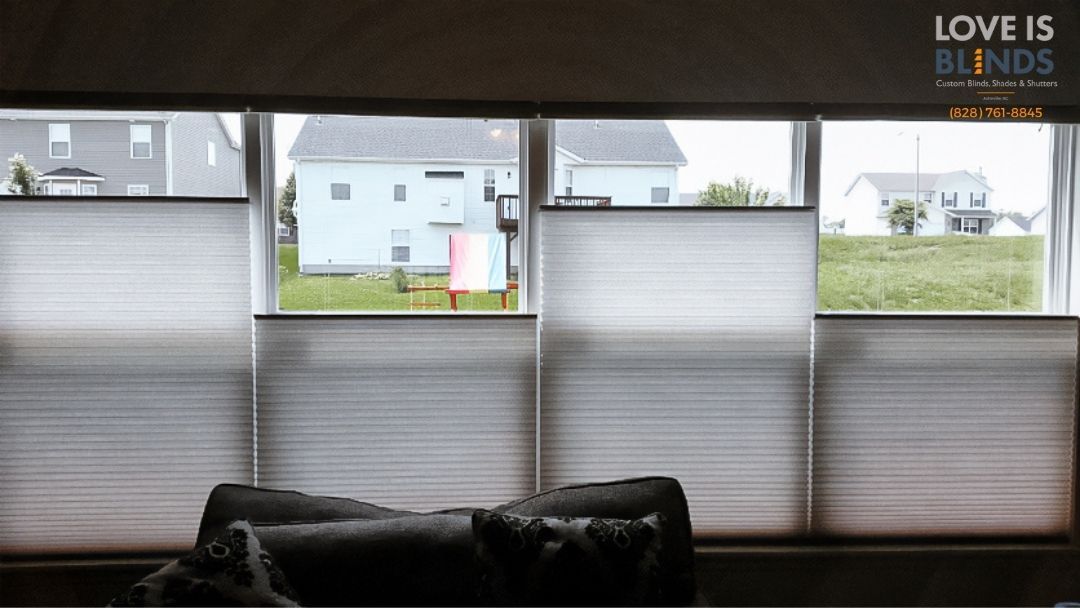
The installation quality of your energy efficient window treatments directly impacts their performance. While DIY installation might seem like a money-saving option, improper installation can reduce efficiency by 50% or more, negating the very benefits you're seeking to achieve. Understanding when to DIY and when to call professionals helps ensure maximum energy savings and long-term satisfaction.
Professional installation offers numerous advantages, particularly for energy efficiency-focused projects. Certified installers understand the critical importance of proper sealing and fit. They have specialized tools for precise measurements, ensuring treatments fit within 1/16 inch tolerances that maximize insulation value. Professionals also identify and address issues DIYers might miss, such as out-of-square windows common in older Asheville homes, settling-related problems, or hidden damage that could compromise installation. Their expertise with local building codes and manufacturer requirements ensures warranties remain valid while achieving optimal performance.
The complexity of energy efficient treatments often demands professional expertise. Cellular shades with continuous cord loops or motorized systems require precise mounting for safe, efficient operation. Side channels and sealing systems that eliminate air gaps need exact alignment that's difficult to achieve without experience. Multi-window installations benefit from professional consistency – ensuring all treatments align perfectly for both aesthetic and functional purposes. In historic homes throughout Montford or Biltmore Village, professionals know how to install treatments without damaging original woodwork or plaster, preserving architectural integrity while improving efficiency.
DIY installation can work for certain situations, particularly simple treatments in standard windows. If you're handy and have proper tools, basic roller shades or simple blinds in newer homes might be manageable. However, even experienced DIYers often struggle with energy efficient treatments' precise requirements. Common mistakes include improper mounting height that creates gaps, inadequate bracket support leading to sagging, misaligned side channels that allow air infiltration, and incorrect programming of motorized systems. Each mistake reduces efficiency and might require expensive professional correction.
Cost considerations extend beyond installation fees. Professional installation typically adds 15-20% to treatment costs but provides value through guaranteed performance, warranty protection, and time savings. Consider that professionals complete installations in hours that might take DIYers entire weekends. They also handle disposal of old treatments and packaging, provide operational training, and offer follow-up support. Many Asheville professionals, including our team at Love Is Blinds NC **(828) 532-2213**, include free energy assessments that identify the best solutions for your specific needs.
Safety factors strongly favor professional installation for certain treatments. Motorized systems require electrical connections that demand proper expertise. Child-safe cordless systems need correct tension adjustment to function properly. Large or high windows pose fall risks for DIYers. Professionals carry insurance and follow OSHA guidelines, protecting both themselves and your property. They also ensure treatments meet Consumer Product Safety Commission requirements for cord safety, particularly important for households with young children or pets.
8. Smart Technology Integration for Ultimate Efficiency
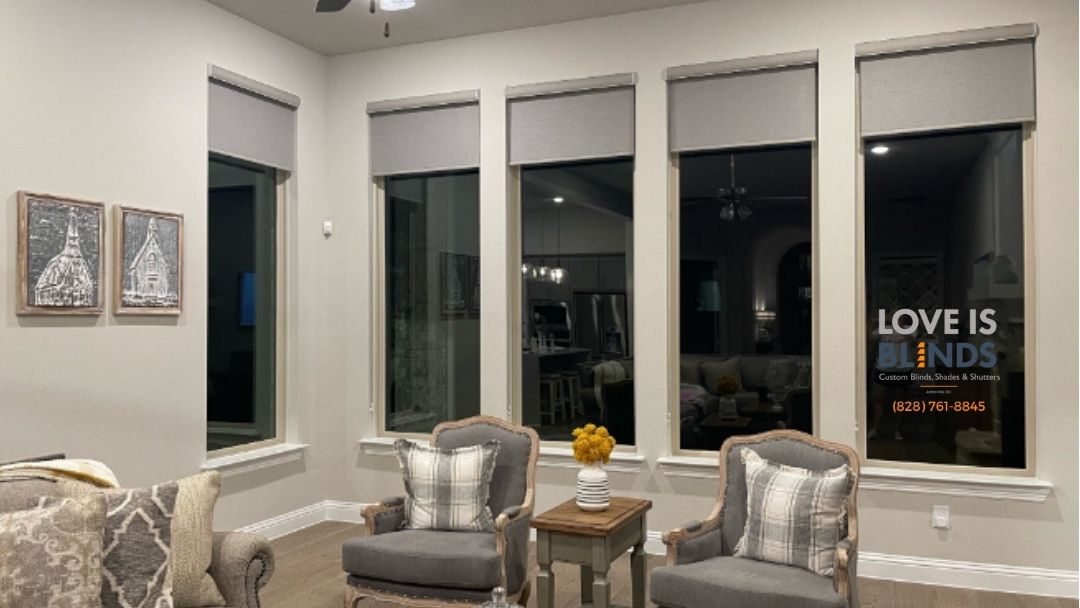
The integration of smart technology with window treatments represents the pinnacle of energy efficiency, combining automated optimization with convenient control. Asheville homeowners increasingly embrace these systems, recognizing that intelligent automation can achieve energy savings impossible through manual operation alone. Smart treatments learn your patterns, respond to environmental conditions, and continuously optimize for comfort and efficiency.
Modern smart window treatment systems offer sophisticated capabilities that seemed like science fiction just years ago. Temperature sensors trigger automatic adjustments when rooms get too hot or cold, maintaining comfort while minimizing HVAC usage. Light sensors respond to changing sun angles throughout the day, automatically adjusting to block glare while maximizing natural light. Integration with weather services allows treatments to prepare for incoming storms or temperature changes – particularly valuable given Asheville's variable mountain weather. Some systems even factor in utility rate schedules, maximizing free solar heating during off-peak hours and providing maximum insulation during expensive peak periods.
Voice control through Alexa, Google Home, or Siri makes adjustments effortless, encouraging optimal use. Instead of manually adjusting multiple windows throughout the day, simple voice commands like "activate summer afternoon mode" can simultaneously adjust all treatments for maximum efficiency. Smartphone apps provide control from anywhere, allowing you to adjust treatments while away from home. Arriving to a perfectly climate-controlled house not only improves comfort but ensures you're not heating or cooling an empty home unnecessarily.
Integration with existing smart home systems multiplies efficiency benefits. When connected to smart thermostats like Nest or Ecobee, window treatments become part of a comprehensive climate control system. The thermostat can signal treatments to close when AC kicks on, reducing cooling load and runtime. Motion sensors ensure treatments only adjust when rooms are occupied, saving energy without sacrificing comfort. Smart lighting systems coordinate with treatments to maintain optimal illumination while minimizing energy use. Whole-home scenes like "good morning" or "movie night" create perfect ambiance while optimizing efficiency.
The data insights provided by smart systems help homeowners understand and improve their energy usage. Detailed reports show when treatments are activated, how much direct sunlight each window receives, and estimated energy savings. This information helps identify problem windows that might benefit from additional treatments or different strategies. Some systems provide suggestions based on usage patterns, learning your preferences while optimizing for efficiency. Over time, these systems become increasingly effective at balancing comfort and energy savings.
Installation and setup of smart systems require careful planning but deliver long-term benefits. Professional installation ensures proper integration with existing systems and optimal sensor placement. Motorization retrofits can upgrade existing manual treatments in many cases, preserving your investment while adding smart capabilities. Battery-powered options eliminate the need for electrical work in many situations, making smart upgrades feasible for any home. Cloud connectivity enables remote troubleshooting and updates, ensuring systems improve over time without requiring service calls.
9. Local Climate Considerations for Western North Carolina
Asheville and Western North Carolina's unique climate presents specific challenges that generic window treatment advice doesn't address. Our mountain location creates microclimates, temperature inversions, and weather patterns that require tailored solutions. Understanding these local factors helps you choose treatments that perform optimally in our specific environment rather than following general guidelines that might work in Charlotte or Raleigh but fall short in the mountains.
Elevation variations throughout the region create dramatically different conditions, sometimes within the same neighborhood. Homes on Town Mountain or in North Asheville's higher elevations experience more extreme temperatures, stronger winds, and greater UV exposure than valley properties. These homes benefit from treatments with higher R-values and superior wind resistance. Valley locations like the River Arts District or Candler face temperature inversions where cold air settles, creating unexpected heating demands. Treatments with excellent seal integrity prevent cold air infiltration during these events.
Humidity management is crucial in our climate, where morning fog is common and afternoon thunderstorms frequent during summer. Excess moisture can lead to condensation between windows and treatments, potentially causing mold or mildew. Quality treatments with proper ventilation gaps allow moisture to escape while maintaining insulation properties. Moisture-resistant materials like vinyl, composite, or specially treated fabrics resist humidity damage that can plague natural materials. During humid periods, treatments that allow some airflow while maintaining privacy and sun protection prove invaluable.
Asheville's storm patterns require treatments that can withstand severe weather while providing emergency protection. Strong mountain thunderstorms with damaging winds occur regularly during summer months. Hurricane remnants occasionally bring tropical storm-force winds and heavy rain. Quality shutters or reinforced treatments provide storm protection beyond their daily energy-saving benefits. Some insurance companies offer premium discounts for homes with storm-rated shutters, recognizing their protective value.
Seasonal allergens, particularly spring pollen, make indoor air quality a major concern for many Western North Carolina residents. Energy efficient treatments that seal tightly help keep allergens outside while reducing the need for open windows during peak pollen periods. This is especially important for the many residents who move here seeking relief from allergies, only to discover our mountain pollen can be intense. Treatments that can be easily cleaned or are naturally antimicrobial help maintain healthy indoor environments year-round.
Solar orientation in mountain terrain differs from flatland assumptions. Mountains, trees, and neighboring structures create complex shading patterns that change seasonally as sun angles shift. Professional assessment considers these factors when recommending treatments. South-facing windows might receive less direct sun than expected if mountains block low winter sun. West-facing windows might need extra protection if they face gaps in ridge lines that funnel afternoon sun. Understanding your home's specific solar exposure throughout the year ensures treatments are optimized for actual conditions rather than theoretical orientations.
10. Maintenance Tips for Long-lasting Energy Efficiency
Proper maintenance of your energy efficient window treatments ensures they continue delivering optimal performance year after year. Like any home system, treatments require regular care to maintain their insulating properties, appearance, and functionality. Establishing a maintenance routine protects your investment while maximizing energy savings throughout the treatment's lifespan, which can exceed 20 years with proper care.
Regular cleaning is essential for maintaining both efficiency and appearance. Dust and dirt accumulation on treatment surfaces reduces their reflective properties, diminishing their ability to manage solar heat gain. Vacuum treatments monthly using a soft brush attachment, working from top to bottom to prevent dust redistribution. For cellular shades, use lowest suction setting to avoid damaging delicate honeycomb structures. Professional cleaning every 12-18 months removes embedded dirt and allergens that regular vacuuming can't reach. Ultrasonic cleaning, available through specialized services, deep-cleans cellular shades without damaging their structure or removing protective coatings.
Inspect hardware and mounting systems quarterly to ensure treatments remain properly aligned and sealed. Check that brackets remain firmly attached to walls or window frames – loose mountings create gaps that allow air infiltration. Tighten any loose screws but avoid overtightening, which can strip holes or crack mounting surfaces. Examine side channels or magnetic seals for proper alignment, adjusting as needed to maintain tight seals. For motorized systems, test operation monthly and listen for unusual sounds that might indicate mechanical issues requiring professional service.
Seasonal adjustments optimize performance as conditions change. Before winter, ensure all treatments close completely and seal tightly against frames. Clean or replace weatherstripping around treatments if gaps have developed. Reverse any reversible treatments to their winter orientation. Before summer, clean reflective surfaces to maximize heat rejection. Check that automated systems' sensors are clean and properly positioned. Update programming for seasonal schedule changes, accounting for daylight saving time and changing sun angles.
Address problems promptly to prevent minor issues from becoming major repairs. Bent slats, torn fabric, or damaged cells compromise both appearance and efficiency. Many issues can be repaired if caught early, but delays often necessitate complete replacement. Keep spare parts like cord locks, mounting brackets, or individual slats for quick repairs. Document warranty information and maintain relationships with installers for professional support when needed. Professional inspection every few years identifies developing problems before they impact performance.
Protect treatments from damage through mindful use and environmental management. Train family members on proper operation to prevent forced movements that can damage mechanisms. Keep furniture and decor items clear of treatments to prevent snagging or interference with operation. Manage indoor humidity to prevent moisture damage – use exhaust fans in bathrooms and kitchens, and consider dehumidifiers during especially humid periods. Protect treatments from direct contact with heating vents or radiators that can cause warping or discoloration. During renovation or painting projects, properly cover or remove treatments to prevent damage from dust, paint, or construction materials.
Frequently Asked Questions About Energy Efficient Window Treatments
Q: How much can I really save on energy bills with efficient window treatments in Asheville? Based on local Duke Energy rates and typical Asheville home characteristics, homeowners can expect to save 10-30% on heating and cooling costs. For an average home spending $2,000 annually on climate control, that's $200-600 in yearly savings. Homes with single-pane windows or poor existing treatments often see even greater savings. The key is choosing appropriate treatments for your specific situation and using them properly throughout the year.
Q: Which rooms should I prioritize for energy efficient treatments? Start with rooms that have the largest windows, receive the most direct sun, or where you spend the most time. Typically, living rooms and master bedrooms provide the best return on investment. South and west-facing windows should be prioritized in summer, while north-facing windows are critical for winter efficiency. Consider your family's patterns – if you work from home, your office might be the top priority.
Q: Can I install energy efficient treatments on historic windows without damage? Absolutely! Many treatments are designed specifically for historic homes and can be installed without drilling into original woodwork. Tension-mounted options, magnetic attachments, or carefully placed brackets in non-historic materials allow you to improve efficiency while preserving architectural integrity. Professional consultation is especially valuable for historic homes to ensure appropriate solutions.
Q: How do energy efficient treatments compare to window replacement for ROI? Window treatments typically offer faster ROI than window replacement. While new windows might provide marginally better efficiency, they cost 5-10 times more than quality treatments. Treatments typically pay for themselves in 3-5 years through energy savings, while window replacement might take 15-20 years. Additionally, treatments can be taken with you if you move, unlike windows.
Q: Do energy efficient treatments make rooms too dark? Modern energy efficient treatments offer excellent light control without creating cave-like conditions. Light-filtering cellular shades provide insulation while maintaining natural light. Top-down/bottom-up options allow light from above while maintaining privacy below. Dual shades offer multiple opacity options in one treatment. Smart systems can automatically adjust throughout the day to balance light and efficiency.
Making Your Asheville Home More Efficient, One Window at a Time
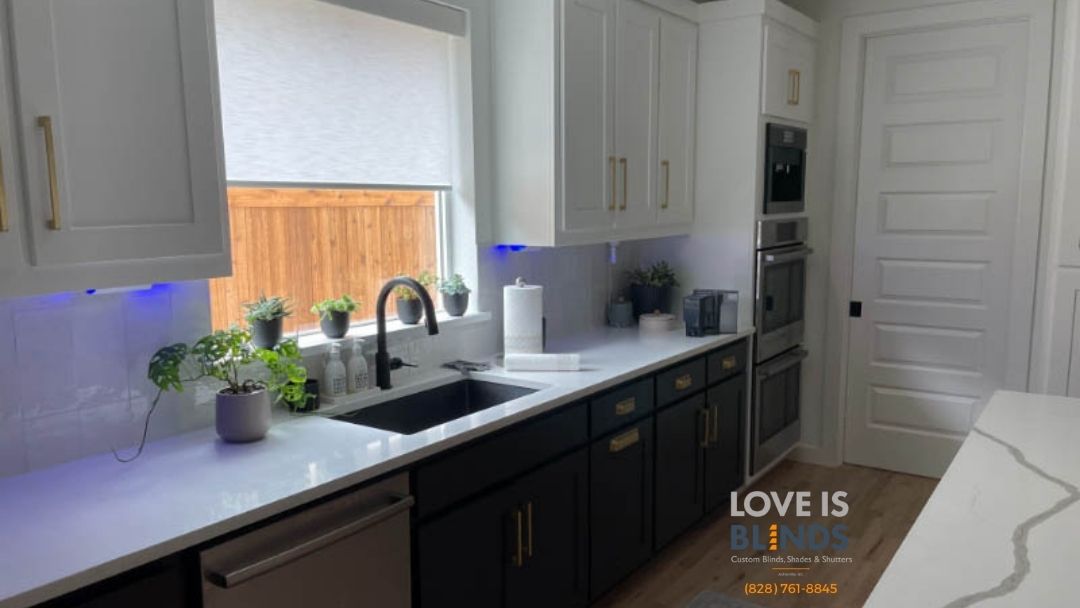
Energy efficient window treatments represent one of the smartest investments Asheville homeowners can make for comfort, savings, and sustainability. With our unique mountain climate presenting both heating and cooling challenges throughout the year, proper window treatments aren't just about aesthetics – they're about creating comfortable, efficient living spaces that work with our environment rather than against it.
The path to energy efficiency doesn't require an all-or-nothing approach. Start with your most problematic windows or highest-use rooms, and expand your treatment upgrades over time as budget allows. Even treating just your south and west-facing windows can yield noticeable comfort improvements and energy savings. Remember that quality treatments installed properly will serve your home for decades, providing returns season after season.
At Love Is Blinds NC, we've helped thousands of Western North Carolina homeowners transform their windows from energy liabilities into efficiency assets. Our decade-plus of experience in the Asheville area means we understand the unique challenges our climate presents and can recommend solutions tailored to your specific home, lifestyle, and budget. From historic Montford cottages to modern mountain estates, we've seen how the right treatments can dramatically improve both comfort and energy efficiency.
Don't let another season pass with your hard-earned money flowing out through inefficient windows. Contact Love Is Blinds NC at (828) 532-2213 to schedule your free in-home consultation. Our experts will assess your windows, explain your options, and help you choose treatments that deliver maximum energy savings while complementing your home's style. We serve all of Western North Carolina, from Arden to Waynesville , bringing professional installation and ongoing support to ensure your treatments perform optimally for years to come.
Your journey to a more comfortable, efficient home starts with a single window. Let's work together to create living spaces that stay comfortable year-round while keeping more money in your pocket. Because here in the mountains, we know that true comfort comes from working with nature, not against it – and that philosophy extends to every window treatment we install.
Love Is Blinds - Custom Blinds, Shades, Shutters
184 Double R Farm Rd, Suite #3
Candler, NC 28715
By Appointment Only
Phone: (828) 532-2213

